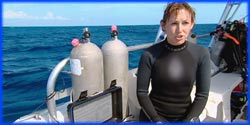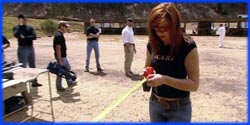


Premier Date: July 10, 2014
plausible
Adam and Jamie first met with a professional trap shooting instructor to learn the basics of hitting moving airborne targets. After practicing on clay pigeons, they returned to the workshop, where Jamie re-configured his soda-can launcher to launch paintball grenades. At the shooting range, they were both able to hit the grenades using 12-gauge birdshot rounds.
To better match typical movie scenarios, in which a character might fire a pistol to hit a grenade, they switched to steel dummy grenades and paintball pistols for safety. Each man took a turn shooting while the other was eventually able to score a hit.
For testing live ammunition and explosives, they built a heavily armored bunker on a remote stretch of land. A test on a standard grenade showed that the explosion would occur 5 seconds after the fuse was ignited by the spoon popping off. They set up a shotgun, pistol, and rifle to fire directly at a grenade once its fuse had been ignited. The 12-gauge buckshot round blew it to pieces and extinguished the blasting cap. The .45 pistol round knocked the cap off; it exploded harmlessly. The .308 rifle round delivered enough energy to the grenade to detonate its explosives instantly. Adam and Jamie classified the myth as plausible, but noted that a person would have a better chance of survival by taking cover due to the difficulty of making an accurate shot and the risk of setting off the grenade.
In the following myths, the Build Team investigated the possibility of surviving a bomb explosion by placing the bomb in a container and diving out of the way. They first set up a 1-pound (450 g) charge of C-4 at the bomb range and detonated it as a control test, with rupture discs placed at distances of up to 20 feet (6.1 m). These discs were calibrated to burst at 13 pounds per square inch (90 kPa), the threshold of shock wave injuries; the disc at 12 feet (3.7 m) was the farthest one that burst.
For each test, they placed the charge in the enclosure, with a rupture disc and Styrofoam cutout figures (to gauge shrapnel injuries) at a distance of 12 feet (3.7 m).
busted
With the charge inside a closed drawer, the cabinet was destroyed. The disc did not burst but the cutouts were shredded.
plausible
The charge was stuffed under the mattress, which was thrown upward by the blast; the disc and cutouts were left intact.
plausible
The charge was placed inside the tank, and the explosion was directed forward and backward; the disc and cutouts, off to one side, were unharmed.
plausible
The charge was placed inside the rear hopper, and disc/cutout groups were placed both directly behind the truck and off to one side. The “behind” disc and cutout were destroyed, while the “side” set remained intact.
The following related myths were shown online.
busted
The cabinet was completely destroyed and deemed to have produced too much shrapnel.
busted
The half inch thick steel safe and the wall were both completely destroyed. The cutouts were shredded.